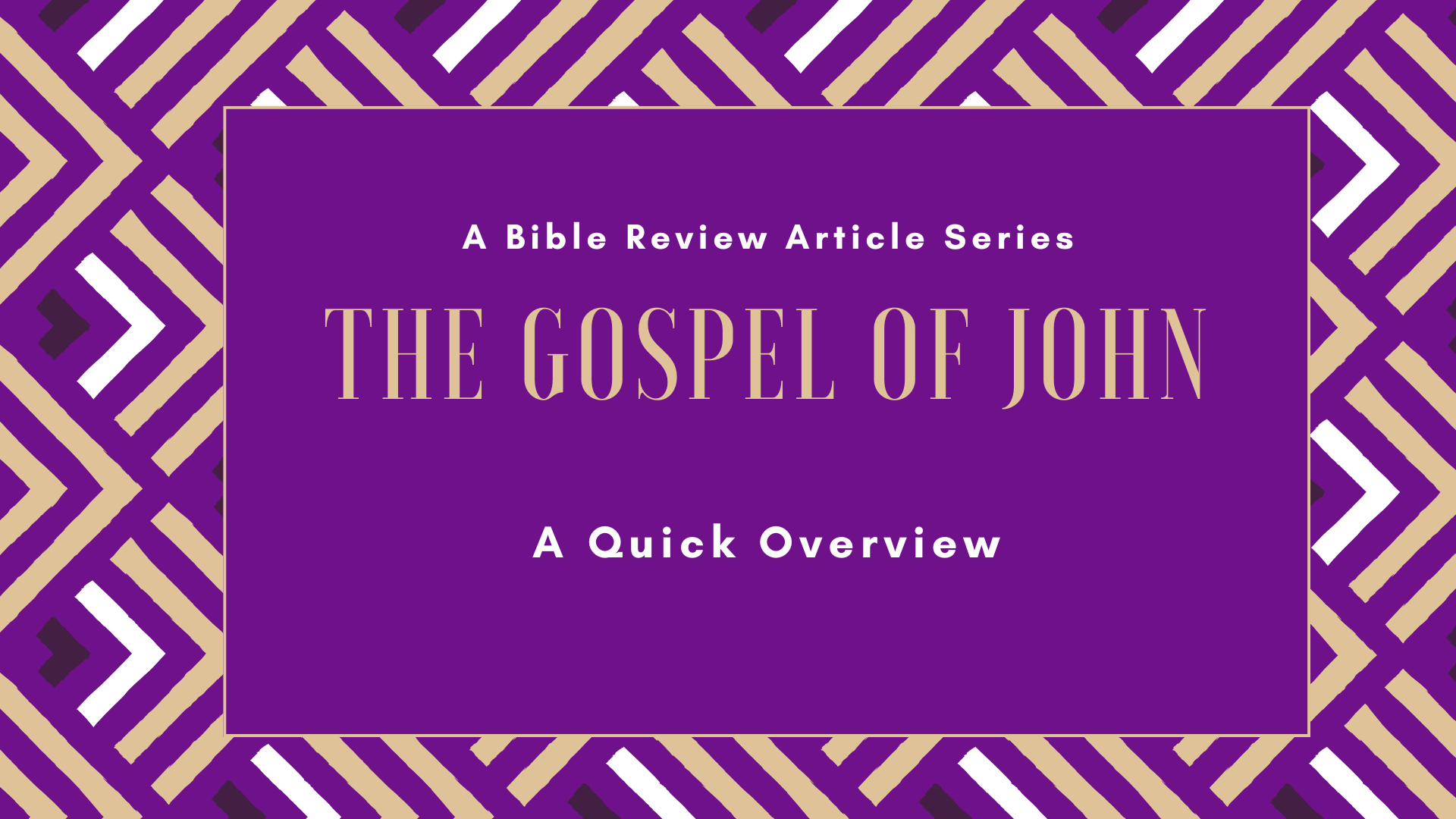
Gospel of John: A Quick Overview
by Milo





Follow us on social media for
FREEBIES and New Article releases.
OR
Sign Up for Our Freebie Email List and Have Freebies Delivered Directly To Your Inbox
Introduction
The Gospel of John presents Jesus as the eternal Son of God who came to bring eternal life. It highlights His divine nature, miracles, and intimate relationship with the Father.
Authorship and Date
Written by John the Apostle, “the disciple whom Jesus loved.” Most scholars date it between AD 85 and 95, making it the last of the four Gospels written.
Purpose and Themes
John writes to inspire belief in Jesus as the Christ and Son of God. Major themes include:
- Jesus as God: Emphasizes His divine nature and eternal existence.
- Faith and Eternal Life: Belief in Jesus leads to life.
- Light and Darkness: Symbolizes spiritual truth versus ignorance and sin.
- Love: God’s love revealed through Christ, calling us to love others.
- Holy Spirit: Promise of the Spirit as helper and teacher.
Key Verses
- John 1:1 – “In the beginning was the Word, and the Word was with God, and the Word was God.”
- John 1:14 – “The Word became flesh and made his dwelling among us.”
- John 3:16 – “For God so loved the world that he gave his one and only Son...”
- John 8:12 – “I am the light of the world...”
- John 14:6 – “I am the way and the truth and the life...”
- John 20:31 – “These are written that you may believe that Jesus is the Messiah...”
Summary of Content
John differs from the Synoptic Gospels (Matthew, Mark, and Luke) by focusing more on Jesus' identity and less on parables. It includes deep theological insights and selected signs that reveal Jesus as the Christ.
Structure of John
- Chapters 1–12: Jesus’ public ministry and signs
- Chapters 13–17: Private teachings and the Last Supper
- Chapters 18–19: Jesus’ arrest, trial, and crucifixion
- Chapter 20: The resurrection
- Chapter 21: Jesus’ post-resurrection appearance
Notable Characters
- Jesus Christ: The Word made flesh, Savior and Son of God
- John the Baptist: Forerunner who testifies about Jesus
- Nicodemus: Pharisee who seeks truth
- Samaritan Woman: Receives living water
- Lazarus: Raised from the dead by Jesus
- Mary and Martha: Sisters of Lazarus, close friends of Jesus
- Pontius Pilate: Roman governor who questions Jesus
- Peter and John: Key disciples; John emphasizes his witness
Application and Relevance
The Gospel of John calls readers to a personal relationship with Jesus through faith. It emphasizes spiritual rebirth, the power of God’s love, and the assurance of eternal life. John's message invites deep trust in who Jesus is and what He came to do.
Connections to Other Books
John connects Genesis (“In the beginning...”) to Jesus as the Creator and Word. It complements the Synoptic Gospels but uniquely contributes a theological depth that highlights Jesus’ deity and the promise of the Holy Spirit, echoed in Acts and the Epistles.
Study Questions
- What does it mean that Jesus is “the Word”?
- Why did Jesus perform signs and miracles?
- What does John 3:16 reveal about God’s character?
- How does Jesus describe Himself in the “I AM” statements?
- What role does the Holy Spirit play in this Gospel?
- Why is the resurrection in John 20 so important?
- What is the significance of Jesus' conversation with Nicodemus?
- How does the Gospel of John define eternal life?
- What does John teach us about love and truth?
- What is your personal response to Jesus' claim in John 14:6?
FAQs and Common Questions
- Who wrote the Gospel of John?
John the Apostle, one of Jesus’ closest disciples.
- What is the purpose of this Gospel?
To inspire belief that Jesus is the Son of God (John 20:31).
- What makes John’s Gospel different?
Focuses on Jesus’ identity and includes unique signs and teachings.
- What are the seven signs in John?
Miracles such as turning water to wine, healing, feeding 5,000, and raising Lazarus.
- What are the “I AM” statements?
Jesus’ declarations of His divine nature (e.g., I am the Bread of Life).
- Is John chronological?
It generally follows a timeline but emphasizes theological meaning over strict chronology.
- How many chapters are in John?
21 chapters.
- What is the significance of John 1:1?
It affirms Jesus’ divine existence from eternity.
- What does John teach about the Holy Spirit?
He is the Counselor who teaches and reminds believers of Jesus’ truth.
- Who is the audience?
A broad audience—both Jews and Gentiles—seeking spiritual truth.
Daily Reading Plan
| Day |
Reading |
| Day 1 | John 1–2 |
| Day 2 | John 3–4 |
| Day 3 | John 5–6 |
| Day 4 | John 7–8 |
| Day 5 | John 9–10 |
| Day 6 | John 11–12 |
| Day 7 | John 13–14 |
| Day 8 | John 15–16 |
| Day 9 | John 17–18 |
| Day 10 | John 19–21 |
More Bible Overviews
Genesis Overview
Exodus Overview
Proverbs Overview
Ecclesiastes Overview
Isaiah Overview
Daniel Overview
Matthew Overview
Gospel of John Overview
Acts Overview
Romans Overview
1 Corinthians Overview
Revelation Overview

Freebie Offers
Sign Up for Our Freebie Email List and Have Freebies Delivered Directly To Your Inbox
Recommended Reading
Feeding Your Spiritual Growth: Best Online Bible Study Platforms
Strengthen Your Spirit: Impactful Bible Study Topics for Believers
Find Your Voice: Expressive Church Journal Prompts for Christians
Journey to Enlightenment: Best Bible Study Tools for Growth
From Busyness to Fruitfulness: A Biblical Approach to Time Management (Part 1)
From Busyness to Fruitfulness: Biblical Strategies for Effective Time Use (Part 2)
SOAP Bible Study and Other Study Methods: Which One is Right for You?
How to Use the SOAP Bible Study Method for a Deeper Walk of Faith
How to Study the Psalms Using the SOAP Method
Applying Biblical Wisdom to Financial Decision-Making
Visit Us on Pinterest









